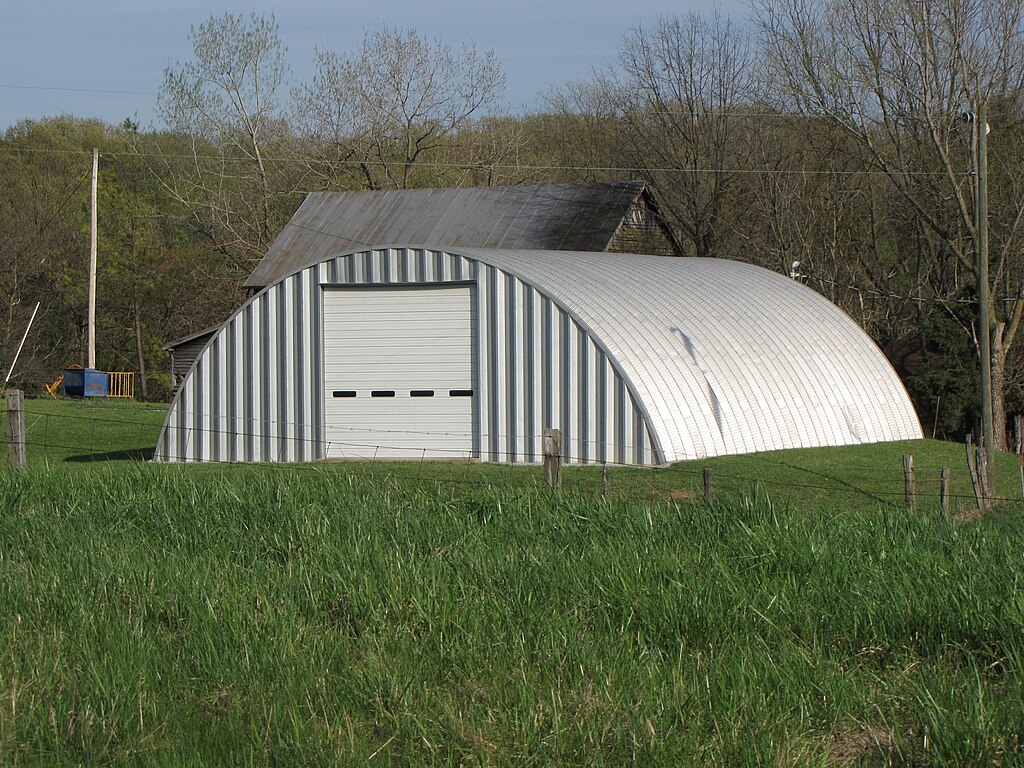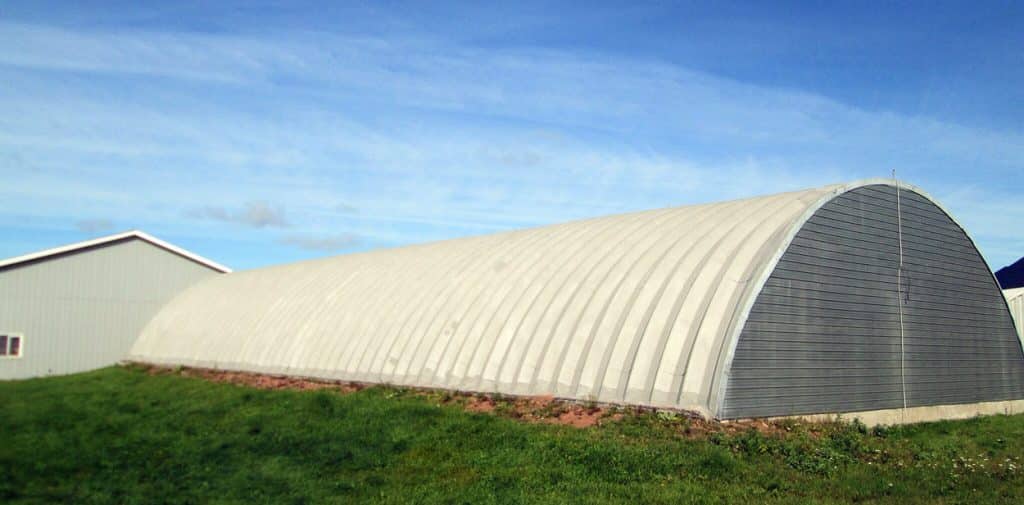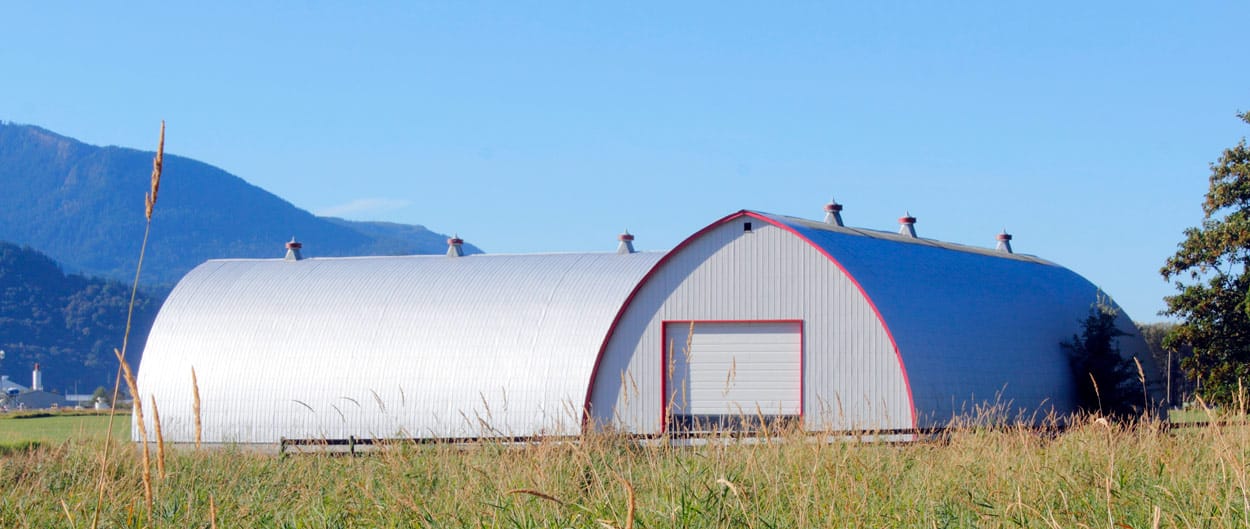If you’ve ever driven by an arch-shaped building and thought to yourself, “That’s an interesting shape for a structure,” you have seen a Quonset hut.
COMPARE PRICES & SAVE UP TO 33%
While Quonset huts were developed for military use originally, today they are becoming popular for a wide range of industrial and residential applications.
The reasons are manifold. Quonset huts are inexpensive, easy to build, and incredibly versatile. In this intro guide, we’ll go over the basics, review their history, and discuss the possibilities for constructing your own Quonset structure.
What is a Quonset Hut?
A Quonset hut is a type of prefab structure consisting of an arch which forms the ceiling and the side walls.
The structure is enclosed by regular, straight walls at the front and back, so it looks like half a cylinder. The vast majority of Quonset huts are made of metal, most often galvanized steel.
The History of Quonset Hut Buildings

If Quonset huts evoke retro military imagery in your mind, that is probably because they got their start during World War II. During that timeframe, the Fuller Construction Company was contracted by the Navy to manufacture buildings which were 1-portable, and 2-fast and easy to put together in remote locations.
Since the personnel on site in some of those locations might lack training in construction or might not have specialized tools with which to work, one of the requirements of Quonset huts was that regular personnel should be able to erect them using the most basic tools.
Where does the name “Quonset” come from? It is a reference to Quonset Point, the Rhode Island Peninsula where the buildings were originally developed. They are sometimes referred to as kwanzaa huts too.
The ease of construction helped the quonset style take off quickly. Not only did they serve their military functions, but civilians also realized their potential swiftly, and quickly began building them for nonmilitary use.
What Materials Are Quonset Structures Made From?
Nearly always, the phrase “Quonset hut” refers specifically to a structure made of galvanized steel. But there are occasional exceptions.
For example, you may encounter Quonset greenhouses on the market. Like other greenhouses, these are made of glass, but they share the same semi-circular cross-sections as traditional Quonset huts.
Quonset Huts vs. Rigid Frame Construction
There are a few different types of metal buildings to choose from, but most commonly, the Quonset hut style is contrasted with rigid frame construction.
A rigid frame steel building consists of a framework of horizontal and vertical metal beams and columns. It is most suitable when large open spaces are required, such as for factories, large retail stores, and warehouses.
There are many advantages to Quonset huts, which I’m going to go over in the section below. So in this section, I will go over a couple drawbacks.
With the arch shape of a Quonset hut, you cannot build as broad a structure with as much available square footage as you can with rigid frame construction. You also do not have the option of building on piers. You need to pour a slab (typically—there are exceptions). So these might be reasons to think about a rigid frame structure instead of a Quonset hut.
What Are the Main Advantages of Quonset Huts?
So why choose a Quonset hut over rigid frame construction?
Here are some of the benefits of steel arch buildings:
- If you are looking for an economical way to build a structure, it is hard to beat the Quonset design. Whereas you would spend around $8 per square foot on average building a rigid frame structure, it should only cost you around $5 per square foot to erect a Quonset hut.
- If you do not have specialized expertise in construction and lack more than basic tools, you might have difficulty with other types of steel building kits. But you should still find it relatively easy to put up a Quonset hut. Remember, they were designed to be as simple as possible to construct in challenging environments where supplies and expertise were limited.
- The amount of time you need to invest in building a Quonset hut may be less than the amount of time it would take you to build another type of steel structure. This too was by design as the military required expedited construction.
- With the curved shape of the roof, you will not need to worry about rain or snow collecting and exerting excess strain on your structure. It should slide right off, making this a particularly suitable option if you have a harsh winter climate.
- Because the Quonset is a recognizable retro design, it is an evocative and nostalgic choice. At the same time, you have the option of finishing it to look as modern as you like.
- Like other metal buildings, Quonset huts are resistant to fire, flooding, and damage from pests. They are low-maintenance and retain their excellent condition with ease for decades.
Just how easy is it to build a Quonset hut?
Once you have the foundation in place (arguably the most involved step) and order your steel building kit, you will notice that you have received a set of panels. You just need to erect them, and then use bolts to attach them one to the next.
How many people you’ll need to work on the structure will depend on its size. If it is a relatively small building, you may be able to handle construction largely or even entirely on your own.
Naturally, the cost savings associated with building your home yourself can be significant, assuming time out of work isn’t an issue. You will find that many building contractors can also handle the process for you if required at a reasonable cost.
What Can You Do With a Quonset Hut?
The possible use cases for Quonset huts are virtually endless. Consider building a Quonset hut for any of the following purposes:
- Residential homes
- Home offices or backyard retreats
- Storage units
- Hangars
- Warehouses
- Retail or other business structures
- Barns
- Classrooms
- Offices
- Garages
How Can You Finish a Quonset Building?

The final look of both the interior and exterior of a Quonset hut are entirely up to you based on your aesthetic preferences and the overall effect you want to aim for.
Many people leave the corrugated metal of their Quonset huts fully exposed on every side, because they enjoy that classic look.
But a lot of people—especially residential customers—do not want a metal exterior, and choose materials which they view as more traditionally “homey” to finish their exteriors. These might include brick, stone or even wood. Glass is an option as well.
As to the interior, you are limited only by your imagination. Again, if you like the classic metal appearance, you can stick with it. But if you want a more traditional look for your home, you can finish it with wood, drywall, or other materials which suit your tastes.
While you are finishing your Quonset hut, make sure to put extra thought into insulating it. Blanket and spray-on insulation is the go-to option, but there are other materials which you can consider as well.
If there is one area of construction where you are going to shell out some extra money, you should consider making it insulation. Why? Because steel has a property called “thermal bridging.” Through thermal bridging, rapid heat transfer takes place.
Standard insulation may not be sufficient to offset the effects of thermal bridging. If your home or business is not sufficiently well-insulated, you will need to pay more to warm it up during the winter or cool it down during the summer.
It makes more sense to put that money into insulation now, because over the long run, it is going to pay off in the form of ongoing savings.
Where Can You Buy a Quonset Hut Building Kit?
A Quonset hut can be an excellent investment. Its value can last a lifetime with proper care.
But getting that value from any steel building begins with finding the right supplier. We can help you find the right vendor in your state.

